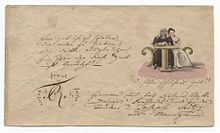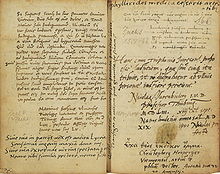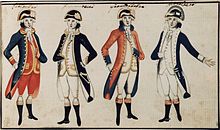Studbook (friendship album)


The pedigree (also album Amicorum ), an early form of poetry album / Friendship book , written during the Reformation , when it fashion was, autographs to collect famous reformers. In the 18th century, family registers were more of a fashion among Protestants than Catholics . These family registers were especially widespread among students until the first decades of the 19th century.
Outstanding because of its furnishings, political significance and because of the entries made by prominent people at the time , the large family register, which was created by the Augsburg merchant Philipp Hainhofer between 1596 and 1647, is outstanding . A distinctive feature set as the collection of sheets 1770 through the in Göttingen active Buchbinder and printer John Carl Wiederhold laid (1743-1826) Stammbuch sheets is.
purpose
In a family book, two or more people insured their friendship by filling out a sheet of paper for each other. This usually happened on special occasions, for example at parties or when leaving the place of study. This entry could be repeated - for example at a reunion or on the occasion of a party. In this way, the owners of the studbooks had a memory of their childhood friends for the rest of their lives.
In addition, it was used to collect autographs from professors (cf. the school scene in Goethe's Faust ) and other "respected persons" (pastors, nobles, celebrities), since the entries were used like letters of recommendation when a student came to a new university. By bringing up an album and asking for an entry from a socially superior inscriber, the owner had the opportunity to get to know potential patrons and protectors.
Content and meaning
The entry consisted at least of a handwritten greeting, mostly with a poem (if possible a self-written) or another literary text. Poems with titles like An * (a (first) name can be used instead of *) were mostly originally intended for a family book.
In the ideal form, in addition to the part of the text that reproduces a poem, literary quotation, song or any other type of sentence, the place and date information on when and where the entry was made. Often the writer also mentions a life motto called a symbol or motto . It is essential to state the name of the person making the entry, which usually includes the faculty at which he is studying and the place of origin. The name was usually preceded by a dedication formula (= dedication text), which sometimes names the addressee (keeper of the family record), and which usually asks for future commemoration ( memoriae causa scripsi ... or "remember when reading these lines ..."). This standardized form has been formally preserved to this day in the poetry albums (primarily) of young girls before puberty .
Studbooks with the entries' own, often colored pen drawings, are particularly interesting. Since not every person could be expected to have the appropriate talent, an industry of its own developed in the 18th century, which offered ready-made graphics as "log book sheets" that were individually labeled and then stapled. Popular motifs were views of university cities or scenes from student life.
The subjects of the entries understandably came from the area that the students experienced together or that particularly connected them. The various forms of student associations that were common in the centuries concerned were then also reflected in these sheets. Since these associations (administered by the students themselves) were generally forbidden until 1848, these archives represent an important historical source for this area of the respective university history. Very little written evidence has survived, particularly from the student orders of the second half of the 18th century . Here the records of the register, with their sometimes very personal entries, are often the only source. For reasons of confidentiality, they invented a large number of cryptographic elements with which they confirmed membership of their order without an outsider being able to prove anything.
The identity symbols, some of which are still used today by the connections, arose from these cryptographic elements. For example, the circle or - in an expanded form - the federal emblem , which still appears in practically every student coat of arms.
New fashions
During the first half of the 19th century the studbook went out of fashion. The function of the friendship souvenir from the student days was now taken over by various couleur objects , which are dedicated and given away ("dedicated"). Beer mugs with color painting enjoyed great popularity , as did other forms of tableware. Silhouettes of the giver in black and white lacquer painting with elaborate color colors soon served as memory. After the invention of photography who came Couleur Photos fashionable until now mostly in black and white, the colors of tape and cap were often einkoloriert by hand.
This custom of “dedicating” couleur gifts is still common and very popular with fraternity students today.
As sources of history
Are regulars books for the story of students and universities are often a valuable source . First of all, it can be used to prove who, when and where studied. In addition, some of the studbook owners entered further life data of their former friends, which means that one has a large number of at least rough résumés of lesser known scholars. In addition, questions related to prosopography and the history of culture or communication come to the fore. The poets quoted in the family books give references to literary fashions among students.
The virtues highlighted in verses in the register are an important source for the history of mentality . However, this does not mean that every statement is to be taken literally, but that the submitters convey an image of themselves as they want to be seen by future readers. There were numerous text collections for the text templates, which offered the right slogan for every occasion.
Since family registers only circulated in private circles and were therefore not subject to censorship, one can expect quite frank political statements there. This is why family records are an important source of German Jacobin research . In fact, there are multiple references to the French Revolution , as well as dates according to the revolution calendar or quotations from revolutionaries. When declaring freedom, however, the student “liberty” is more often meant than political freedom .
Famous family books

- Ludwig van Beethoven's family book, in: Max Braubach (ed.): The family books of Beethovens and Babette Koch , Bonn 1995, ISBN 3-88188-008-9 .
- Babette Koch's family book, in Max Braubach (ed.): The family books of Beethovens and Babette Koch , Bonn 1995, ISBN 3-88188-008-9 .
- The records of Isaac Coppenhagen, in Ingrid Bodsch : Harry Heine stud. juris in Bonn 1819/1820 , Bonn 1997, ISBN 3-931878-05-8 .
- The Richertz'sche Stammbuch from 1737, Rostock; Original in the Berlin Art Library; Reprint from 1919 for the 500th anniversary of the University of Rostock.
- The studbook of Friedrich von Matthissons . Facsimile, transcription and commentary on the facsimile. Edited, commented on and with an afterword by Erichwege, Doris and Peter Walser-Wilhelm and Christine Holliger in collaboration with Bonstettiana, Archive and Edition and the Anhaltische Landesbücherei Dessau. Vol. 1-2. Göttingen 2007. ISBN 978-3-8353-0002-6 .
- Werner Moritz: Jacob Grimms Stammbuch. Journal of the Association for Hessian History and Regional Studies 94 (1989), pp. 153–168.
See also
- Friendship book
- Festschrift
- Leaves of Memory (Schmiedeberg)
- Serre's student album
- Poetry album , also short for poetry
literature
- Duke August d. J. - Das Stammbuch (1592–1605) . 10 postcards. Herzog August Library Wolfenbüttel [Re. Tübingen], undated
- Robert Keil, Richard Keil: The German family records of the sixteenth to nineteenth centuries. Seriousness and joke, wisdom and vacillation in original communications on German cultural history. Grote, Berlin 1893, ( digitized version ).
- Walter Blankenburg, Fritz Lometsch : Monument of friendship. Student records 1790–1840 (= print of the ark. ) 60, ZDB -ID 844773-1 . Lometsch, Kassel 1969.
- Lotte Kurras: In good memory. Cultural-historical miniatures from family records of the Germanisches Nationalmuseum. 1550-1770. Prestel, Munich 1987, ISBN 3-7913-0827-0 .
- Hans Günther Bickert, Norbert Nail: Lovable Lahn-Athens. The 300th anniversary of the Philipps University. The first honorary doctorate for a woman. A look at the Marburg family books (= publications of the Marburg University Library. 65). Marburg University Library, Marburg 1992, ISBN 3-8185-0123-8 .
- Christine Göhmann-Lehmann: "Friendship - for a lifetime ..." Written culture of remembrance for women. Museumsdorf Cloppenburg, Cloppenburg 1994, ISBN 3-923675-36-4 (exhibition catalog).
- Norbert Nail: “Semper funny. Nunquam sad. “Marburg students in Conrad Westermayr's studbook. In: Alma mater philippina. Summer semester 1994, ISSN 0569-082X , pp. 22-25, (illustrated).
- Horst Steinhilber: From virtue to freedom. Student mentalities at German universities 1740–1800 (= historical texts and studies. 14). Olms, Hildesheim et al. 1995, ISBN 3-487-10028-2 (at the same time: Stuttgart, University, dissertation, 1994).
- Werner Taegert : Noble treasure of fond memories. Pictures in the records of the Bamberg State Library from four centuries. Bamberg State Library, Bamberg 1995, ISBN 3-924530-08-4 .
- Rolf Wilhelm Brednich : Monuments of friendship. The Göttinger Stammbuchkupfer - sources of cultural history. Bremer, Friedland 1997, ISBN 3-9803783-1-4 .
- Walter M. Brod: From a Franconian family register - Bütthard and surroundings. Pages in the register from Michael Joseph Weber's student days, Würzburg. 1817-1822. Institute for University Studies, Würzburg 1997.
- Friendship monument. Family books and poetry albums from five centuries. An exhibition in the SLUB Book Museum, February 25 to June 27, 1998. Saxon State Library - Dresden State and University Library, Dresden 1998.
- Gilbert Hess: Literature in a life context. Text and meaning constitution in the family book of Duke August the Younger of Braunschweig-Lüneburg (1579–1666) (= microcosm. Contributions to literary studies and meaning research. 67). Lang, Frankfurt am Main et al. 2002, ISBN 3-631-38070-4 (at the same time: Munich, Ludwig Maximilians University, dissertation, 2001).
- Rosemarie Schillemeit (Ed.): The family book of Benedict Christian Avenarius. Evidence of a student and court master life in Göttingen, Braunschweig and in Leipzig of the young Goethe. With explanations and a biography (= Braunschweig contributions to the German language and literature. 4). Publishing house for regional history, Bielefeld et al. 2002, ISBN 3-89534-344-7 .
- Werner Wilhelm Schnabel : "Kurtz = meaning = rich sayings". Baroque sample collections for album inscriptions. In: Morgen-Glantz. Journal of the Christian Knorr von Rosenroth Society. 12, 2002, ISSN 0942-0924 , pp. 101-133.
- Werner Wilhelm Schnabel: The family register. Constitution and history of a type-related collective form up to the first third of the 18th century (= early modern times. 78). Niemeyer, Tübingen 2003, ISBN 3-484-36578-1 (also: Erlangen-Nürnberg, Universität, habilitation paper, 2000).
- Stud book of Johann Bernhard Wilhelm Sternberger from Meiningen, student of law in Jena since 1773. Jena, Thuringian University and State Library, starboard 90. Facsimile. 2 volumes (facsimile volume commentary volume by Joachim Ott). Friedrich Schiller University Jena and others, Jena 2004, ISBN 3-9809040-9-1 .
- Ulrich Rasche: Cornelius relegatus in engravings and images from the archives of the early 17th century. On the memory of student class culture in its formation phase. In: 450 years of the University of Jena (= then and now . 53). Schmidt, Neustadt an der Aisch 2008, ISBN 978-3-87707-717-7 , pp. 15–47.
- Volker Schäfer: The register of the Tübingen donor August Faber with his Hölderlin entry from 1789. In: Sönke Lorenz , Volker Schäfer (Ed.): Tubingensia. Impulses for the city and university history. Festschrift for Wilfried Setzler on his 65th birthday (= Tübingen building blocks for regional history. 10). Jan Thorbecke, Ostfildern 2008, ISBN 978-3-7995-5510-4 , pp. 397-426.
- Nicole Domka / Eva Raffel / Gerd Brinkhus (eds.): In eternal friendship. Studbooks from Weimar and Tübingen, Cultural Office of the University City, Tübingen 2009 (Tübingen Catalogs, Volume 83), ISBN 978-3-910090-92-7 .
- Werner Wilhelm Schnabel: Self-presentation in texts and pictures. Studbooks and entries in the logbook from Helmstedt. In: Jens Bruning, Ulrike Gleixner (Ed.): The Athens of the Welfs. The Reform University of Helmstedt 1576–1810 (= exhibition catalogs of the Herzog-August-Bibliothek. 92). Harrassowitz, Wiesbaden 2010, ISBN 978-3-447-06210-7 , pp. 68-77.
- Werner Wilhelm Schnabel: family records. In: Ulrich Rasche (Ed.): Sources on early modern university history. Types, stocks, research perspectives (= Wolfenbütteler Forschungen. 128). Harrassowitz, Wiesbaden 2011, ISBN 978-3-447-06604-4 , pp. 421-452.
- Ralf-Torsten Speler (Ed.): Vivat Academia, Vivant Professores! Halle student life in the 18th century (= Martin Luther University Halle-Wittenberg. Catalog of the University Museum of the Central Custody. NF 7). Martin Luther University Halle-Wittenberg - Central Custody and University Museum, Halle 2011, ISBN 978-3-86829-348-7 .
- Eva Raffel: Goethe, Galilei and Co. Friendship books of the Duchess Anna Amalia Library, Meissner, Berlin 2012, ISBN 978-3-87527-120-1 .
- Ferdinand Ahuis , Walther Ludwig (Hrsg.): The album Reformatorum Cygnaeum (1542/1543) in the magnificent Bible of the Zwickau mayor Oswald Lasan. With an introduction by Ferdinand Ahuis. Hauswedell, Stuttgart 2013, ISBN 978-3-7762-0513-8 .
- Jan-Andrea Bernhard: The album Amicorum by Ursula Staehelin from St. Gallen. A contribution to the history of peregrination and communication. In: Writings of the Association for the History of Lake Constance and its Surroundings. Vol. 131, 2013, ISSN 0342-2070 , pp. 185-197.
- David Paisey: A German student's album in the British Library. Lauingen, Wittenberg and Tübingen, 1580–1588. In: William A. Kelly, Jürgen Beyer (Eds.): The German book in Wolfenbüttel and abroad. Studies presented to Ulrich Kopp in his retirement (= Studies in reading and book culture. 1). University of Tartu Press, Tartu 2014, ISBN 978-9949-32-494-1 , pp. 261-278.
- Werner Wilhelm Schnabel: The album Amicorum. A mixed media collection medium and some of its variations. In: Anke Kramer, Annegret Pelz (Hrsg.): Album. Organizational form of narrative coherence. Wallstein, Göttingen 2013, ISBN 978-3-8353-1174-9 , pp. 213-239, ( open access : FWF-E-Book-Library: https://e-book.fwf.ac.at/o: 340 ).
- Margarete Zimmermann , Stephanie Bung: Salon albums. Collective memorials of the early modern period with an excursus on 'La Guirlande de Julie. In: Anke Kramer, Annegret Pelz (Hrsg.): Album. Organizational form of narrative coherence. Wallstein, Göttingen 2013, ISBN 978-3-8353-1174-9 , pp. 254-270, ( open access : FWF-E-Book-Library: https://e-book.fwf.ac.at/o: 340 ).
- Georg Objartel : Memorabilia in student records. In: Georg Objartel: Language and way of life of German students in the 18th and 19th centuries. Articles and documents (= Studia Linguistica Germanica. 123). De Gruyter, Berlin et al. 2016, ISBN 978-3-11-045399-7 , pp. 105-126.
- Peter Hartwig Graepel: Pharmacy historically relevant family books. Autographs by German pharmacists. Miniatures with pharmacy views and pharmaceutical activities (= Gladenbacher contributions to the history of the German pharmacy. 3). Peter Hartwig Graepel, Gladenbach 2016, ISBN 978-3-00-050342-9 .
Web links
- References to internet sources and literature
- Repertorium Alborum Amicorum (RAA) - International directory of studbooks and fragments of studbooks in public and private collections
- Silke Cecilie Moning: The student records of the 18th century. University of Giessen, accessed on May 5, 2016 .
- Studbook pictures in then and now (VfcG)
- The Richertz 'stud book
Individual evidence
- ↑ oV : Goettingen University history - pedigree leaves on the side kulturerbe.niedersachsen.de [no date], as last accessed on 18 October 2017



